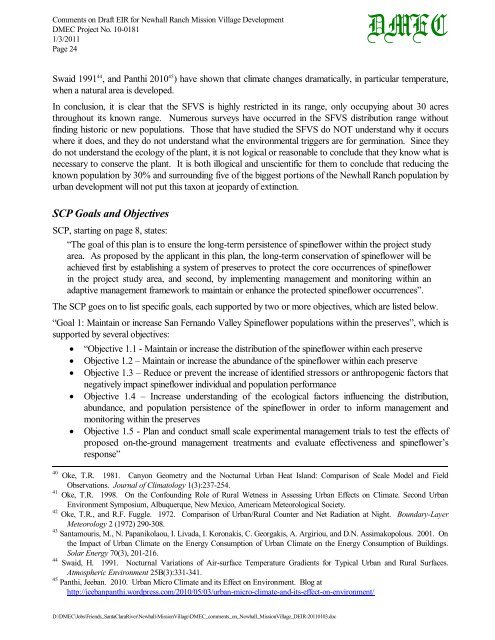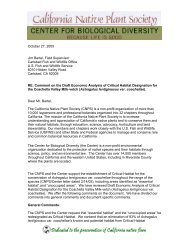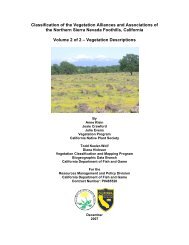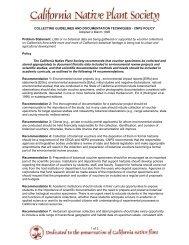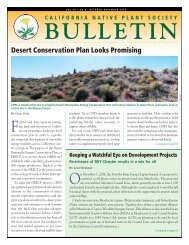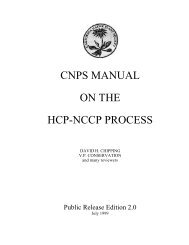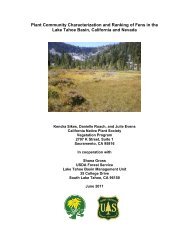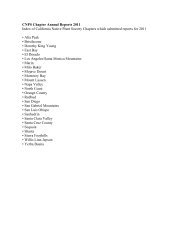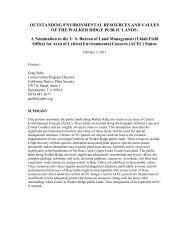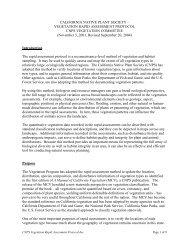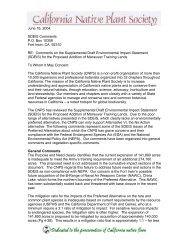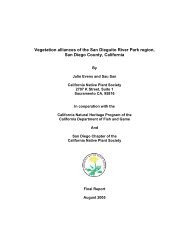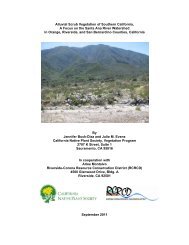David Magney Environmental Consulting - California Native Plant ...
David Magney Environmental Consulting - California Native Plant ...
David Magney Environmental Consulting - California Native Plant ...
Create successful ePaper yourself
Turn your PDF publications into a flip-book with our unique Google optimized e-Paper software.
Comments on Draft EIR for Newhall Ranch Mission Village Development<br />
DMEC Project No. 10-0181<br />
1/3/2011<br />
Page 24<br />
D:\DMEC\Jobs\Friends_SantaClaraRiver\Newhall-MissionVillage\DMEC_comments_on_Newhall_MissionVillage_DEIR-20110103.doc<br />
DMEC<br />
Swaid 1991 44 , and Panthi 2010 45 ) have shown that climate changes dramatically, in particular temperature,<br />
when a natural area is developed.<br />
In conclusion, it is clear that the SFVS is highly restricted in its range, only occupying about 30 acres<br />
throughout its known range. Numerous surveys have occurred in the SFVS distribution range without<br />
finding historic or new populations. Those that have studied the SFVS do NOT understand why it occurs<br />
where it does, and they do not understand what the environmental triggers are for germination. Since they<br />
do not understand the ecology of the plant, it is not logical or reasonable to conclude that they know what is<br />
necessary to conserve the plant. It is both illogical and unscientific for them to conclude that reducing the<br />
known population by 30% and surrounding five of the biggest portions of the Newhall Ranch population by<br />
urban development will not put this taxon at jeopardy of extinction.<br />
SCP Goals and Objectives<br />
SCP, starting on page 8, states:<br />
“The goal of this plan is to ensure the long-term persistence of spineflower within the project study<br />
area. As proposed by the applicant in this plan, the long-term conservation of spineflower will be<br />
achieved first by establishing a system of preserves to protect the core occurrences of spineflower<br />
in the project study area, and second, by implementing management and monitoring within an<br />
adaptive management framework to maintain or enhance the protected spineflower occurrences”.<br />
The SCP goes on to list specific goals, each supported by two or more objectives, which are listed below.<br />
“Goal 1: Maintain or increase San Fernando Valley Spineflower populations within the preserves”, which is<br />
supported by several objectives:<br />
�� “Objective 1.1 - Maintain or increase the distribution of the spineflower within each preserve<br />
�� Objective 1.2 – Maintain or increase the abundance of the spineflower within each preserve<br />
�� Objective 1.3 – Reduce or prevent the increase of identified stressors or anthropogenic factors that<br />
negatively impact spineflower individual and population performance<br />
�� Objective 1.4 – Increase understanding of the ecological factors influencing the distribution,<br />
abundance, and population persistence of the spineflower in order to inform management and<br />
monitoring within the preserves<br />
�� Objective 1.5 - Plan and conduct small scale experimental management trials to test the effects of<br />
proposed on-the-ground management treatments and evaluate effectiveness and spineflower’s<br />
response”<br />
40<br />
Oke, T.R. 1981. Canyon Geometry and the Nocturnal Urban Heat Island: Comparison of Scale Model and Field<br />
Observations. Journal of Climatology 1(3):237-254.<br />
41<br />
Oke, T.R. 1998. On the Confounding Role of Rural Wetness in Assessing Urban Effects on Climate. Second Urban<br />
Environment Symposium, Albuquerque, New Mexico, Americam Meteorological Society.<br />
42<br />
Oke, T.R., and R.F. Fuggle. 1972. Comparison of Urban/Rural Counter and Net Radiation at Night. Boundary-Layer<br />
Meteorology 2 (1972) 290-308.<br />
43<br />
Santamouris, M., N. Papanikolaou, I. Livada, I. Koronakis, C. Georgakis, A. Argiriou, and D.N. Assimakopolous. 2001. On<br />
the Impact of Urban Climate on the Energy Consumption of Urban Climate on the Energy Consumption of Buildings.<br />
Solar Energy 70(3), 201-216.<br />
44<br />
Swaid, H. 1991. Nocturnal Variations of Air-surface Temperature Gradients for Typical Urban and Rural Surfaces.<br />
Atmospheric Environment 25B(3):331-341.<br />
45<br />
Panthi, Jeeban. 2010. Urban Micro Climate and its Effect on Environment. Blog at<br />
http://jeebanpanthi.wordpress.com/2010/05/03/urban-micro-climate-and-its-effect-on-environment/


